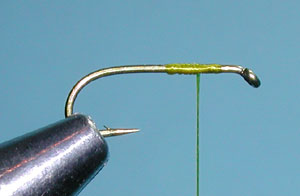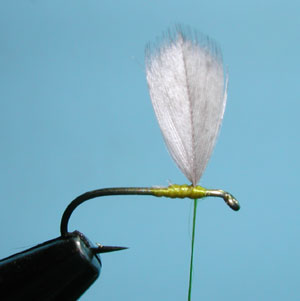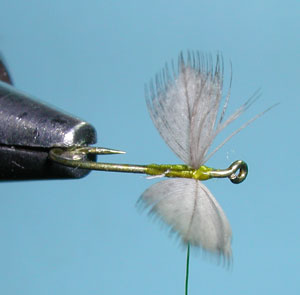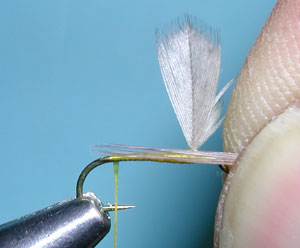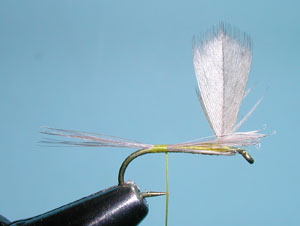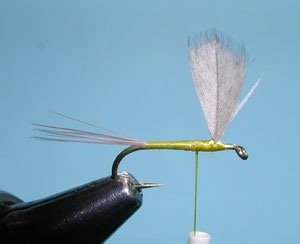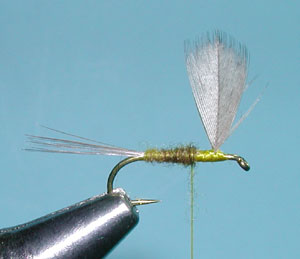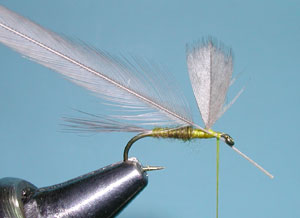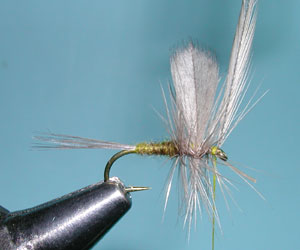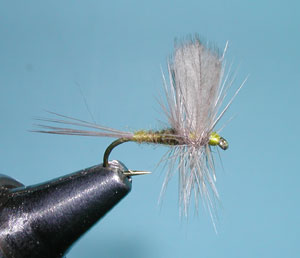Catskill Drys
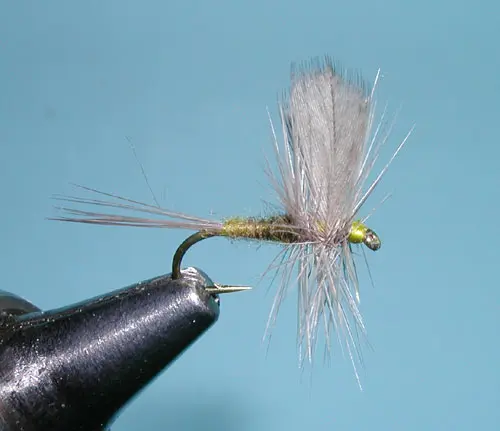
Blue Wing Olive
Tying Instructions
| Materials
to Order Material, click the link |
|
|---|---|
| Hook | TMC 100 #16-20 or Daiichi 1180 #16-20 |
| Thread | Danville Flymaster 6/0 Light Olive |
| Body | Blue Wing Olive Superfine |
| Tail | 8-12 Medium Dun Spade Hackle Fibers |
| Wing | Dun Hen Hackle Tip |
| Hackle | Med. Dun Hackle |
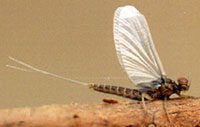
Catskill Drys
The Catskill dries are a traditional pattern from the Catskill Region of Upper New York. They are variations of earlier British Chalkstream patterns, particularly those of Frederic Halford. The Catskill Dries represent mayflies with a hackle fiber tail, thin bodies, upright wings and hackle collars. The use of hackles are much heavier and stiffer than their British counterparts due to the more turbulent water of the Catskills needing better floatation. Thus, our Wulff patterns became even more heavily hackled with thicker bodies for our larger Western streams.
Theodore Gordon
 Early American fly tiers, such as Theodore Gordon (photo at right), began tying the Catskill pattern in the late 1800’s with his Quill Gordon. Gordon is considered the American “Father of the Dry Fly” , a title shared by his counterpart Frederick Halford in Great Britain. The two were actually close friends and Halford introduced Gordon to the dry flies he was using in Britain with a large sample of flies sent in February 22, 1890. It was soon evident that Halford’s flies would need to be adapted to the wilder rivers and streams of the Eastern United States.
Early American fly tiers, such as Theodore Gordon (photo at right), began tying the Catskill pattern in the late 1800’s with his Quill Gordon. Gordon is considered the American “Father of the Dry Fly” , a title shared by his counterpart Frederick Halford in Great Britain. The two were actually close friends and Halford introduced Gordon to the dry flies he was using in Britain with a large sample of flies sent in February 22, 1890. It was soon evident that Halford’s flies would need to be adapted to the wilder rivers and streams of the Eastern United States.
Afterwards, Gordon set out to design his own patterns with the Quill Gordon, Light Cahill, March Brown, Gray Fox, and the fan wing Royal Coachman. These dressings are rather sparse with thin tapered bodies and stiff, glossy hackles. The favored wing material was the lemon barred side of the wood duck. The tails are also stiff, glossy hackles that would lift the fly well above the water surface. Accordingly, this was an aspect that Halford insisted upon as well.
Early American Tiers
The pattern style continued with Rueben Cross, who developed the Catskill hackling technique of wrapping the hackle on both sides of the wing. This hackling technique was followed by Walt Dette and Harry Darbee in the 1920’s. Consequently, Catskill Dries became very effective in the smaller creeks and streams and was particularly useful within the Sierra. Probably the most famous Catskill Dry is the Adams by Leonard Halladay, which tends to be considered an attractor dry but also is a good choice for gray drakes and small gray duns.
Important Catskill Dries
Important Catskill Dries for the Sierra are the Blue Wing Olive (BWO and Green Drakes) and the Light Cahill (Sulfurs and Pale Morning Duns) named after Dan Cahill, a railroad brakeman and an accomplished fly tier in 1880. The Light Cahill pattern was later modified by Theodore Gordon. Other important Catskill dries, as well, are the Red Quill (March Browns and Mahogany Duns) created by Art Flick in 1933, and the Quill Gordon by Theodore Gordon in 1890.
Quill Gordons actually do not reside within the Sierra (they are an Appalachian Mayfly). However, the pattern makes a great attractor mayfly pattern on sierran streams and are similar to Mahogany Duns.
Fishing the Catskill Drys
Most mayflies emerge from the bottom of the streambed and swim to the surface. Once at the surface, the wings will spread out and the mayfly is considered to be in the dun stage. Thus, a Hare’s Ear Wet Fly does a good job in matching the emergent stage, using a Leisenring Lift to mimic the swimming action.
The dry flies represent the dun stage after the mayfly reaches the surface. Often these duns get caught in eddies where the larger trout will anticipate an easy meal. Other promising areas are the feeding lanes within the lower sections of pools. Trout often hold in front of a boulder in this section sipping the duns as they drift to them. Consequently, the presentation of the fly needs to be cast at least 2 feet above the boulder location from a position at least ten feet below the boulder. Be sure to hold the rod tip high to minimize drag.
Hatches
Many of the duns hatch during the midday when the water warms up. Afterwards, during the late afternoon, mayflies will become involved in egg-laying and some will become trapped within the water film as Spinners. Both Spinner patterns and the Catskill patterns will work during this time period. The Mahogany Duns (Paraleptophebia) will often hatch in the Spring (April and May) but also in the Fall (September and October) within the slow eddies when the water temps reach about 50 degrees. You will find that our Sierra Mahogany Duns tend to be larger sizes of 12-16.
Variations
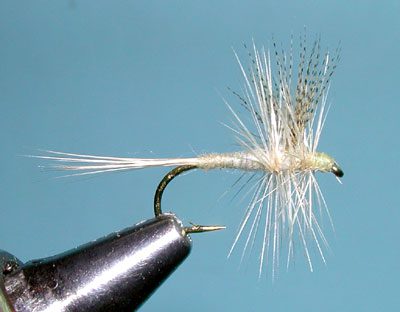
Light Cahill
| Hook | TMC 100, #12-20 |
| Thread | Uni-thread 8/0 Light Cahill |
| Body | Light Cahill Superfine |
| Tail | Light Ginger Spade Hackle Fibers |
| Wing | Dyed Mallard Flank Woodduck, upright and divided |
| Hackle | Light Ginger |
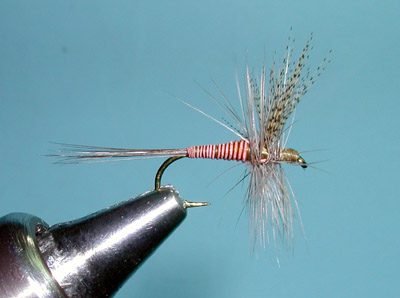
Red Quill
| Hook | TMC 100, #12-18 |
| Thread | Danville Flymaster 6/0 Olive |
| Body | Red Quill Body |
| Tail | Med. Dun Spade Hackles |
| Wing | Dyed Mallard Flank Woodduck, upright and divided |
| Hackle | Med. Dun |

Quill Gordon
| Hook | TMC 100, #12-16 |
| Thread | Danville Flymaster 6/0 Tan |
| Body | 2 Stripped Peacock Quill |
| Thorax | PMD Superfine |
| Tail | Medium Dun Spade Hackle Fibers |
| Wing | Dyed Mallard Flank Woodduck, upright and divided |
| Hackle | Med Dun |

Mahogany Dun
| Hook | TMC 100, #12-16 |
| Thread | Uni-Thread 6/0 Dark Brown |
| Body | Stripped Furnace Quills |
| Tail | Coq de Leon Tailing Fibers Medium Pardo |
| Wing | Natural Mallard Flank, upright and divided |
| Hackle | Golden Badger Hackle |

